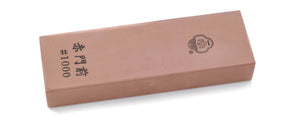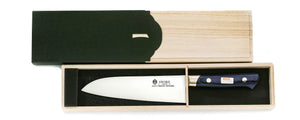JO Series
"Jo" comes from the kanji 穣, and once meant good fertility around harvesting produce. This series combines a Blue Steel #2 blade with a rustic, kurouchi finish. The Jo Series has a sharp and tough cutting edge, complimented by unpolished "black rust".
Black rust—the original steel's color, helps stop damaging red rust from forming on the knife.
These double-edged knives work in either hand.
| Product number | Actual Blade Length (mm) | Full Length (mm) | Total Weight (g) |
|---|---|---|---|
| 1hbjg-210 | 210 | 360 | 150 |
| Blade | Material Name | Handle |
|---|---|---|

Double Edged |
Blue Steel #2 | Walnut wood with buffalo horn bolster |

Gyuto
Gyuto, literally means "Beef knife". The Japanese did not consume beef until it began to modernise with increased Western influence in the late 1800's. During that period, when Japanese thought of Western food, they thought of giant slabs of beef being cut and grilled or stewed, thus the "Gyuto" was born. In modern times it is the most common knife in Japanese households, with also the most variety of steel,blade lengths and handle materials available.

Blue Steel #2
Adding tungsten, chromium, and alloy carbides to White Steel makes for a tough, chip-resistant blade.
Carbon Steel
Blue Steel #2 is made by adding trace amounts of tungsten and alloy carbides (both for hardness), and chromium (for toughness and rust resistance) to White Steel, creating an alloy steel that is very tightly bonded. This also leads to better edge retention compared to White Steel #2, so you can cut better for longer. Professional chefs looking to enter the next level of quality will often choose a Blue Steel #2 knife, but beginners can use this also.
*NOTE: Carbon Steel is susceptible to rust if it is not properly cared for. Please clean and dry the blade regularly during use and after use.

Forge Welded
Forge Welded knives undergo a forging process where steel is heated to high temperatures and then shaped with a hammer. This carefully done process changes the internal structure of the steel, producing a blade with superior hardness levels. Highly skilled craftspeople forge, quench, and create the knife's cutting edge by hand, resulting in a sharp blade with long edge retention.

Optional Engraving
Optional Engraving Service
Sakai Ichimonji provides complimentary engraving using either Japanese Kanji or English Alphabet. Please specify your preference. For details, please visit here
A knife store that has supported the history of knives and food culture in Japan.
It has been 600 years since the birth of swordmaking in the Sakai region of Japan. Sakai Ichimonji Mitsuhide's and it's craftsmen continue to build on that legacy by producing the finest blades in Japan.
This is where the culture of completing a dish of sashimi by "just cutting" and the culture of expressing sharpness as "taste" was born.
For 70 years, we have been connecting the spirit of Sakai's craftsmen with the passion of chefs in Osaka's kitchen equipment shopping district, known as the kitchen of Japan.
We are very happy that our knives can be used by people all over the world.
Precautions
After use, wash off any dirt and wipe thoroughly with a dry cloth to remove any moisture. This product is not for use with frozen foods.This product is handmade, so each piece will be different. Please use the weight and length listed as a guide. Each material is natural and may vary in color. It is not the same as the picture.We take great care with our inventory, but in the unlikely event that we are out of stock, we will contact you by email to let you know.








































